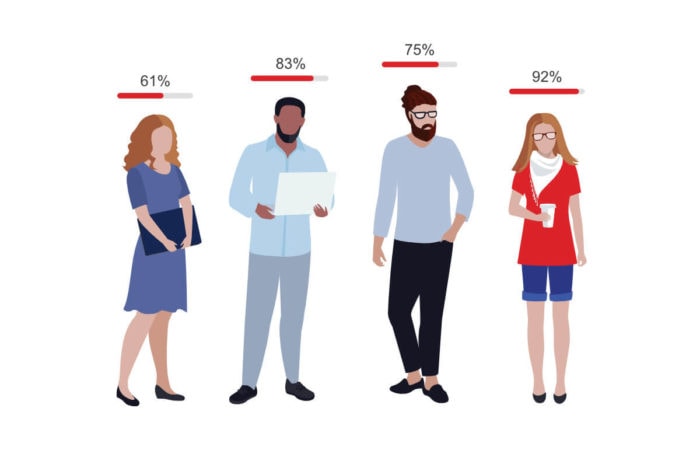The Nature of Work Is Changing, and So Does Employee Experience: Interview with Brian Kropp from Gartner
Talent Development Priorities: What L&D Leaders Should Focus on
Recently, LinkedIn released its 2018 Workplace Learning Report to highlight the latest L&D trends. It was a global survey involving 1,200 L&D and HR professionals, 400 people managers, 200 executives, and 2,200 employees from North America, Europe, and Asia.
The report touches upon the top priorities for L&D programs in 2018, listed below:
- How to train for soft skills
- Consistent valuable global training
- Delivering insights on internal skill gaps
- How to track skill development
- How to assess skill competencies
- Understanding the impact of technology
We are going to dive into each of these priorities, finding answers to the top five questions and explaining why we don’t see the sixth point as a priority for L&D programs in 2018.
1. How to train for soft skills

There’s no denying that soft skills will always be vital for the workplace, since working alongside machines requires the development of people skills at a high level. According to the LinkedIn report, the most sought-after soft skills are leadership (65%), communication (64%), and collaboration (55%). This list also includes creativity, critical thinking, adaptability, time management, and problem-solving skills.
What soft skills can you train with the right learning platform?
A training platform with social learning capabilities can help you not only develop social skills but also ensure that each individual stays connected and performs harmoniously within a company. With extensive social features, you can improve:
- Teamwork and collaboration
No matter if teams are geographically dispersed or placed in one room, with a set of group or direct chats, discussion boards, and seamless file sharing, each team member is equipped with everything necessary for successful teamwork.
- Communication
To avoid miscommunications and ensure an overarching reach to all employees, social features within platforms are a must. Whether there’s a need to discuss some specific subject, explain company’s policies, give feedback on performance, or discuss recent product launches, social features such as instant messaging, file sharing, and virtual meetings are indispensable assistants.
- Leadership
Streamlined communication builds trust while on-demand, relevant feedback contributes to engagement and helps to detect and fix performance issues at the early stages. Thanks to a wide range of social features, employees stay connected to their managers, in turn, managers keep track of what’s going on, being always ready to help when employees encounter difficulties.
- Creativity and innovation
When communication is meaningful, dynamic, and interactive, it creates a favorable environment for creativity. Consequently, when water cooler talks are supported by interesting videos, podcasts, blog articles, group discussions, and user-generated content; it opens a door to new, innovative ideas and off-the-wall solutions.
- Problem-solving
They say a problem shared is a problem halved. Discussions with like-minded people about work-related issues and productive teamwork can enhance problem-solving skills, as we always learn through communication. Moreover, while working on a solution together with colleagues via the use of discussion boards, group chats, or virtual meetings, employees also create the perfect environment for creative ideas.
Though role-specific skills rank only fourth (42%), they can’t be left unaddressed. L&D professionals need to balance the development of both soft skills and technical skills. Yes, AI and technologies can outperform people in many spheres, but they can’t do everything (not yet, at least). Moreover, you still need experts who can fix these machines, enhance their functions, and add more features for better results.
2. How to provide consistent, valuable global training

The LinkedIn Report shows that the first challenge is getting employees to make time for learning. At the same time, 56% of employees say that they would take a training course if it was suggested by their manager. Here comes the second challenge: Talent developers struggle to get managers involved in employee learning. This is crucial because a high level of manager involvement can contribute greatly to employees’ learning experience and increase their engagement.
The third challenge for talent developers is balancing today’s challenges with tomorrow’s opportunities. According to the LinkedIn findings, L&D professionals mostly focus on meeting employees’ current needs. However, executives and managers want them to think ahead and identify future industry trends to prevent internal skill gaps.
Learning platforms can help deliver consistent global training
One of the report highlights indicates that L&D professionals depend on online learning solutions more than ever before in order to meet the needs of an increasingly diverse, multi-generational workforce.
People managers are motivated to encourage learning when it is tied to a path to promotion and when they have a system that can help recommend learning opportunities.
Having a scalable, data-driven learning platform, at the heart of which lies personalization, companies can deliver consistent training at scale by:
- Giving 24/7 access to training material which employees can learn via any device;
- Focusing on each employees’ performance metrics and offering relevant content to bridge knowledge and skill gaps;
- Giving constant feedback and analyzing the most common performance issues employees encounter;
- Timely updating training content to meet company’s needs of today; and
- Ensuring streamlined communication across all departments, teams, and team members within a company.
Since modern learning platforms are built on the just-in-time principle and offer microlearning as the main way to consume new material, employees don’t have to find time for their learning; they learn while working. Today’s learning should be tightly integrated into daily operations.
3. How to deliver insights on internal skill gaps

The LinkedIn report emphasizes that the short shelf life of skills and a tightening labor market are giving rise to a multitude of skill gaps. Businesses are fighting to stay ahead of the curve, trying to hold onto their best talent and struggling to fill key positions.
Such conditions require continuous training that can solve two L&D challenges at once: a) developing current talent within a company by addressing recurring skill gaps; and b) future-proofing a company and maintaining its competitive ability thanks to its highly-skilled workforce.
One way to gain insights on internal skill gaps is ongoing communication between employees and managers to track workflow. However, the most accurate assessment of skill gaps and performance issues can be obtained using a smart learning platform analytics engine. With real-time tracking, analytics dashboards, and reports that a smart learning platform offers, L&D leaders can easily deliver critical insights into employees’ performance and their skill gaps.
4. How to track skill development

According to the report, executives assess the success of L&D programs by the impact of learning on retaining top talent (68%), increases in performance metrics (65%), and employee feedback about the ability to apply training (47%).
LinkedIn offers two ways of tracking the success of a training program:
- Look at team metrics before and after relevant team training.
- Note the retention rate at the start of a new program. Six months to a year after the launch of a new learning initiative, measure the retention rate again to see if there has been an increase in retention and/or a decrease in employee turnover.
What’s more, the report states that talent developers use learning solutions not only to deliver training content but also to measure learning success. If a learning platform allows managers and L&D leaders to gain meaningful insights into employees’ performance and their skill gaps, then the tracking of skill development is not in question. Firstly, analytics provides performance data for both employees and teams. Thus, managers can see where they encounter difficulties and vice versa, where they succeed. Such tracking allows managers and L&D leaders to offer targeted training to promptly address any skill gaps.
5. How to assess skill competencies

The last point raises a question. What is actually meant by “assess”? If we consider skill competencies as professional qualities that recruiters usually look for in candidates when assessing whether they are a good fit for a company or not, then we’re talking about key competencies a person should possess for the job role in question. It could be tech skills, specific job-related knowledge, as well as a set of soft skills.
In this case, “How can we assess skill competencies?” means “How do we identify the level of skills a person has?” It’s all about professional expertise, starting from the initial analysis of the key skills required for a certain job and ending with the actual candidate’s skill assessment.
Good news for recruiters: Technology and data will do “the dirty work”. Thanks to big data, recruiters can eliminate the guesswork. Technology will facilitate the hiring of a perfect match by offering automated resume screening, recruitment chatbots, data analytics, and even de-biasing software.
Understanding the impact of technology: Is it a priority in 2018?
As for the understanding the impact of technology, we think it can’t be called a priority for L&D programs in 2018. Not anymore. It was a must in 2017, as well as in 2016 and in prior years. Now it should be regarded as a matter of course. It’s our reality. And it’s not only a matter of understanding, it’s also of readiness, acceptance, adaptability, and the implementation of technology for the sake of learning improvement and facilitation both for employees and talent developers.
But what really matters and is highlighted in the report is that L&D professionals are now “relationship builders”, being responsible for cultivating the relationships that are the backbone of a learning culture which thrives in a workforce of constant change. Their role is to shape future workforce strategy, while delivering hyper-relevant content to support employees’ needs of today and to cater these vast efforts to a multi-generational workforce with varied learning preferences. We believe that the development of the learning culture for the sake of a company’s future is what should be among L&D priorities.
Click here for your demo and see how Rallyware helps enterprises with large sales forces cut expenses, drive revenue, and transform operations.
News and Insights on Workforce Training & Engagement
We’re among top-notch eLearning and business engagement platforms recognized for effective training and talent development, helping to empower distributed workforces
Subscribe
